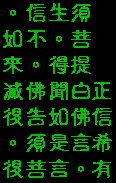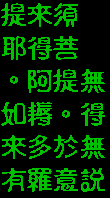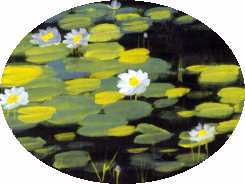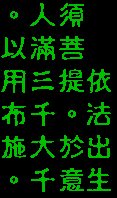CONTENTS
The Proper Belief With No Attachment
Commentary on Chapter 6 "Proper Belief Is Rare"
The Buddha told Subhuti, "Do not speak in such a way!
After the Tathagata's extinction, in the last five hundred years, there
will be those who hold the precepts and cultivate blessings who will
believe such phrases and accept them as true.
"You should know that such people will have planted good roots with
not just one Buddha, two Buddhas, three, four or five Buddhas, but will
have planted good roots with measureless millions of Buddhas. All
who hear such phrases and produce even one thought of pure faith
are completely known and completely seen by the Tathagata. Such living
beings thus obtain measureless blessings and virtue. And why? Those
living beings have no further mark of self, of others, of living beings,
or of a life; no mark of dharmas and no mark of no dharmas. If living
beings' hearts grasp at marks, then that is attachment to self, to others,
to living beings, and to a life. For that reason you should not grasp
at dharmas, nor should you grasp at no dharmas. Regarding that principle,
the Tathagata often says, 'All you Bhiksus should know that
the dharma which I speak is like a raft. Even dharmas should be
relinquished, how much the more so no dharmas."
 Subhuti said to the Buddha, "World Honored One, in
the future will there be living beings, who, when they hear such
phrases spoken will truly believe?"
Subhuti said to the Buddha, "World Honored One, in
the future will there be living beings, who, when they hear such
phrases spoken will truly believe?"
Following Buddha's elaboration on the wonderful conduct of a bodhisattva without dwelling, Subhuti raises a concern if people will believe in the Diamond Sutra in the future. In the reply, the Buddha talks about how such proper belief will be possible in the future. However, such belief will be very rare.
The "future" the Buddha talks about is "the last five hundred years", which actually covers our present time. The 20th Century is in the so-called Period of the Last Dharma, which is the last of the 3 Periods: Period of the Proper Dharma, Period of the Adopted Dharma and Period of the Last Dharma. The Period of the Last Dharma will last for 10,000 years. "The last five hundred years" refers to the first five hundred years of this last period. In this period, it is very rare to find people with the proper belief.
The Buddha says that the people with the proper belief are those who hold the precepts and cultivate blessings. Holding precepts refers to maintaining the Five Precepts or the Eight Precepts. Cultivating blessings refers to the act of giving.
The Buddha further elaborates on who can become those people (or more generally, the living beings) with proper belief. The criterion is that they have planted good roots for countless number of kalpas, with "measureless millions of Buddhas". Good roots are another name for Dharma Body of Budha, which is also our own Buddha nature. Good roots are the firm foundations which derive from cultivation, and manifest our Dharma Body and improve our wisdom.
As to the concept of Proper Belief, the Buddha emphasizes on the point of "no mark". An enlightened being should have:

Most disciples of the Buddha have attained the fruit of Arhat, i.e., they have emptied the perception of self as well as others, sentient beings and a life. However, they have not emptied out the perception of Dharma. The Buddha preaches the Diamond Sutra to help them empty out their perception of Dhrma, and thus they can break up their attachment to Dharma.
All Dharmas are conditioned, without their own nature and their existence is inter- dependent. They are impermanent, unreal and empty in nature. Therefore we should not attach to them. Similarly, the perception of no-Dharma is also conditioned and empty in nature. We should not attach to no-Dharma as well.
The Buddha further specifies that one should not grasp at Dharmas, nor grasp at no-Dharmas. In order to make the point clearer, the Buddha mentions the famous metaphor of the raft. The Dharma is like the raft. The raft carries us to the shore. When we get to the shore, we give up the raft and come to the land. In the same way, we should relinquish the Dharma when we attain the enlightenment.
Commentary on Chapter 7 "Nothing Attained, Nothing Spoken"
Subhuti said, "As I understand what the Buddha has
said, there is no concrete dharma called Anuttarasamyaksambodhi, and
there is no concrete dharma which the Tathagata has spoken. And why?
The dharmas spoken by the Tathagata cannot be grasped and cannot be spoken.
They are neither dharmas nor no dharmas. And why? Unconditioned dharmas distinguish
worthy sages."
 "Subhuti, What do you think? Has the Tathagata
attained Anuttarasamyaksambodhi? Has the Tathagata spoken any dharma?"
"Subhuti, What do you think? Has the Tathagata
attained Anuttarasamyaksambodhi? Has the Tathagata spoken any dharma?"
In this chapter, the Buddha challenges Subhuti with the question:
Subhuti answers that:
Subhuti further explains that:
 Subhuti concludes that it is the unconditioned Dharma that distinguishes the worthy sages.
Unconditioned Dharma is non-active and characterized by its lack of marks. Since it is
void of marks, it cannot be discriminated and is absolute. In the final analysis, the idea of
unconditioned Dharma cannot be expressed in words. It is inconceivable. It is this highest
state of virtues and mind that the worthy sages have attained or achieved. The sages
prevail and excel by means of the unconditioned Dharma. The sages are recognized,
characterized or defined by the unconditioned Dharma. Once all attachments have be
relinguished, the basic substance of the Dharmabody os a being is attained and the
original face is recognized.
Subhuti concludes that it is the unconditioned Dharma that distinguishes the worthy sages.
Unconditioned Dharma is non-active and characterized by its lack of marks. Since it is
void of marks, it cannot be discriminated and is absolute. In the final analysis, the idea of
unconditioned Dharma cannot be expressed in words. It is inconceivable. It is this highest
state of virtues and mind that the worthy sages have attained or achieved. The sages
prevail and excel by means of the unconditioned Dharma. The sages are recognized,
characterized or defined by the unconditioned Dharma. Once all attachments have be
relinguished, the basic substance of the Dharmabody os a being is attained and the
original face is recognized.
The Buddha's teaching is spoken because there are people. The medicine is prescribed because there is sickness. It is like sweeping the floor when it is dusty. The Dharma spoken is the Dharma-dust which the Tathagata (or Buddha) sweeps away. The Dharma cannot be grasped. It is not Dharma nor no-Dharma. What Dharmas are there ? There are none. There isn't anything at all.
The Blessings From Diamond Sutra
Commentary on Chapter 8 "Relying On Dharma They Come Forth"
Subhuti said, "Very many, World Honored One. And
why? Such blessings and virtue are not of the nature of blessings and virtue.
Therefore the Tathagata speaks of many blessings and virtue."
"If, on the other hand, a person were to receive
and hold from this Sutra even so few as four lines of verse and speak
them for others, his blessings would surpass the previous ones. And
why? Subhuti, all Buddhas and all Buddhas dharma of Anuttarasamyaksambodhi
come forth from this Sutra. Subhuti, the Buddhadharmas spoken are
no Buddhadharmas."
 "Subhuti, what do you think, if someone filled
three thousand great thousand world systems with the seven precious gems
and gave them as a gift, would he obtain many blessing and virtue?"
"Subhuti, what do you think, if someone filled
three thousand great thousand world systems with the seven precious gems
and gave them as a gift, would he obtain many blessing and virtue?"
In this chapter, it is stated that all Buddhas and all Bodhisattvas are brought forth from this Diamond Sutra.
In order to illustrate this point, the Buddha asks Subhuti how many blessings and virtues one can acquire if one is to fill 3000 "Great Thousand World Systems" with seven precious gems and give them away as offerings.
Here the Great Thousand World System is a gigantic world composed of 1000 Middle- Thousand Worlds, each is made up by 1000 Small-Thousand Worlds. Each Small- Thousand World is formed by 1000 World Systems, and in a single World System there is the Mount Sumeru, 4 Great Continents, a sun and a moon.
In other words, the Buddha is trying to describe the vastness of the givings and thus draws a picture how immense the blessings and virtues can be obtained through such offerings.
Subhuti answers that the blessings thus obtained are very many. But he elaborates that such blesings and virtues can be counted and therefore can be considered very many. However, since such blessings are obtained through the materialistic offerings, they are not of the real nature of blessings and virtues.
In contrast to such materialistic offering, the Buddha talks about the blessings and virtues a person were to receive and hold from this Diamond Sutra. The Buddha says that even so few as four lines of verse and the person speaks them for others, the blessings thus obtained would surpass those in the previous paragraphs obtained from giving away those vast amounts of gems.
The four lines of verse refer to the four-line gatha in chapter 5:

This gatha is the affirmative way of expressing the same idesa as in another four-line gatha appearing later in the Sutra:
Receiving and holding the Sutra is self-benefitting cultivation which leads to self- enlightenment. Explaining it to others benefits and enlightens them. The Buddha says that if you can receive and hold a four-line gatha yourself, and speak it for others, the blessings and virtues of that act are far greater than the blessings and virtues derived by the person who gives three thousand Great-Thousand World Systemful of the seven precious gems as gift.
The giving of Dharma is the most supreme kind of giving and as such far surpasses the giving of wealth. The Buddha says that all Buddhas and all Buddhas Dharma of Anuttarasamyaksambodhi come forth from this Diamond Sutra.
At the end of this chapter, the Buddha makes a very important remark: the Buddha-Dharmas spoken are no Buddha-Dharmas. If you are attached to the Buddha, you are attached to the mark of the people. If you are attached to the Dharma then you are attached to the mark of Dharma. The Dharma of the Unsurpassed, Proper and Equal, Right Enlightenment to which the Buddhas have certified, flow from markless real-mark prajna. True Buddha-Dharma is devoid of form or appearance. It is true emptiness and wonderful existence. One should rely on Dharma to cultivate, but should have no attachment to the mark of the Dharma. One has the blessings and virtues, but should not be attached to their mark. If one has no attachments, one's merits and virtues shall exhaust empty space and pervade the Dharma realm.
This point of "Buddha-Dharma is no Buddha-Dharma" can be illustrated by what the Sixth Patriarch Hui-nam says:
Those who can truly put everything down and investigate the meaning of that, can attain genuine, originally existent real mark prajna, and see that Buddha-Dharma is no Buddha-Dharma.







